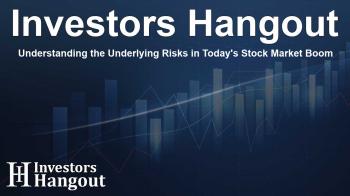Understanding the Underlying Risks in Today's Stock Market Boom

The Current Stock Market Landscape
As we observe the stock market reaching unprecedented highs, it's crucial to understand the hidden factors contributing to this ascent. A significant drive behind these record numbers is the ongoing credit expansion, often referred to as the increasing debt levels. This scenario brings forth the concepts espoused by economist Ludwig von Mises, particularly the idea of a Crack-Up Boom, which signifies unsustainable economic growth driven by excessive credit.
The Implications of Rising Debt
Today, the collective debt in the United States has surpassed $36 trillion, with forecasts suggesting it could approach $40 trillion. This situation paints a picture of an economy that is thriving on borrowed time and funds. As investors and market watchers, it’s essential to differentiate between perceived growth and genuine economic health, especially when celebrating positive reports, such as unexpectedly good payroll figures, which could be subject to revisions or inflated perceptions.
Understanding Credit and Debt's Impact
The essence of a Crack-Up Boom lies in the chaotic nature of credit and debt in our economic system. Credit flows freely within the economy as long as confidence remains, allowing investors to pour resources into assets indiscriminately. Over time, however, the increasing debt levels lead to inflationary pressures that undermine the currency's value, prompting investors to seek refuge in tangible assets rather than rely on a compromised currency.
Inflationary Pressures and Market Behavior
The current economic landscape shows that long-term interest rates are climbing, influenced by the ongoing inflationary policies that have been implemented to stave off market downturns. Such policies often exacerbate the cycle of borrowing and lend themselves to creating an economic environment characterized by stagflation—where stagnant growth and rising inflation coexist.
The Consequences of Ongoing Economic Policies
Market signals indicate a resistance to this cycle of excessive inflationary measures. The Treasury market is notably responding, suggesting that corrective measures need to be taken to address the ongoing inflationary trends. As the economy grapples with the consequences of increasing debt, we see a transition toward tighter monetary policies that may bring about significant changes in investment strategies.
Commodity Markets and Economic Strategy
Recently, there has been a shift towards viewing commodities more favorably, especially as commodity prices, such as silver, begin to show signs of recovery compared to gold. While the stock market may continue to participate in this economic boom for some time, it is expected to face challenges ahead due to the corrosive effects of stagflation. Adopting a strategic approach that considers these dynamics becomes increasingly important.
Preparing for Future Market Corrections
Whether we witness a market correction or not remains to be seen, yet both paths suggest further inflationary policies are on the horizon. Each scenario presents its own challenges and opportunities. Hence, it's vital to stay informed and adaptable, continuously evaluating market relationships and dynamics to navigate this volatile atmosphere effectively.
Frequently Asked Questions
What is a Crack-Up Boom?
A Crack-Up Boom is a term that describes a situation where rapid credit expansion leads to inflationary pressures, culminating in a potential economic collapse.
How does rising debt influence the economy?
Increasing debt can create an illusion of growth by facilitating more spending, but it can also lead to inflation, currency devaluation, and economic instability over time.
What are the signs of approaching stagflation?
Stagflation manifests as stagnant economic growth coupled with rising prices, making it difficult for investors and policymakers to stimulate growth without exacerbating inflation.
How should investors prepare for market volatility?
Investors should diversify their portfolios, stay informed about economic indicators, and be adaptable to changes in market conditions to optimize their strategies.
Are commodities a reliable investment during inflationary periods?
Commodities often serve as a hedge against inflation, as their intrinsic value tends to rise when currency values decline, making them a potentially reliable investment choice.
About The Author
Contact Riley Hayes privately here. Or send an email with ATTN: Riley Hayes as the subject to contact@investorshangout.com.
About Investors Hangout
Investors Hangout is a leading online stock forum for financial discussion and learning, offering a wide range of free tools and resources. It draws in traders of all levels, who exchange market knowledge, investigate trading tactics, and keep an eye on industry developments in real time. Featuring financial articles, stock message boards, quotes, charts, company profiles, and live news updates. Through cooperative learning and a wealth of informational resources, it helps users from novices creating their first portfolios to experts honing their techniques. Join Investors Hangout today: https://investorshangout.com/
The content of this article is based on factual, publicly available information and does not represent legal, financial, or investment advice. Investors Hangout does not offer financial advice, and the author is not a licensed financial advisor. Consult a qualified advisor before making any financial or investment decisions based on this article. This article should not be considered advice to purchase, sell, or hold any securities or other investments. If any of the material provided here is inaccurate, please contact us for corrections.

